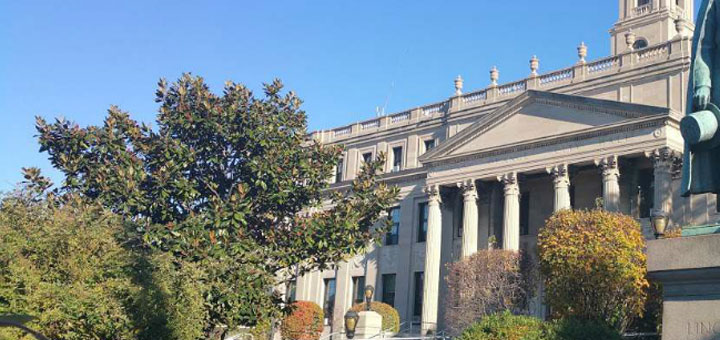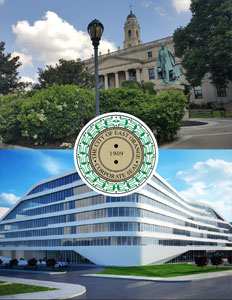Amherst, Massachusetts
Setting the standard for urban excellence
Lester Taylor became the mayor of East Orange, New Jersey on January 1, 2014. He is the 13th mayor in the city’s history and the second youngest person ever elected to run this four square-mile municipality of 65,000 people, some eight miles due west of New York City. His vision for East Orange is that it will set a new standard for urban excellence and become a “destination city.” Taylor says that when he first assumed office, he saw the need for a rallying cry that would put in perspective the monumental tasks that confronted his new administration. The first thing he did was to embrace the concept of “urban” in order to strip the term of some of its negative connotations. “In New Jersey and other cities around the country, when stories are written about ‘urban,’ they’re always about blight,” he says. “But we look at urban as a positive lifestyle. We’re seeing people being priced out of the east, whether in New York, or Hoboken and Jersey City, and moving further west. And we’re seeing people from the west wanting to move from the suburbs back into areas that are more convenient and accessible without having to drive a substantial distance.
“Now that the housing market is rebounding, East Orange is at the right price and the right place to take advantage of investment and getting a return on that investment, whereas in other areas of the state and county, real estate is far more expensive. We are seeing dozens, if not hundreds of our new tenants that are coming to our existing units and some of the newly-constructed units, are New Yorkers, or they are people who live in New Jersey and work in New York. But it’s far more convenient to be in East Orange and it’s far more affordable than it may be in other areas.”
Thus, Taylor sees East Orange’s destiny tied strongly to its location as a transportation hub. “East Orange is well-situated – right off of Highway 280, right off of the Garden State Parkway, two or three miles off of the New Jersey Turnpike, with access to every other major artery to east or west and north or south in the state,” he explains. “We have two train stations in our city – East Orange and Brick Church – each of which has direct access to New York’s Penn Station in about 24 minutes. And so, our ‘destination’ is our transportation; it’s how we attract investment; how we attract residents, and how we attract businesses to want to locate here.”
In fact, East Orange is what is known as a “transit village.” A transit village is a predominantly residential development with some nearby retail activities planned around a transportation hub, such as a train station, with the intent to make it convenient for village dwellers to get to and from work or run errands and travel via a public transportation network. “So, we are working aggressively to attract investment with all the incentives that come along with a transit village destination,” Taylor says, “in order to promote multi-modal transportation with less reliance on cars, and more on bike to and from the rail. We just designated a developer for a project commonly known as 20/30 Evergreen Street. The site has been vacant for nearly two decades. A developer has plans to bring mixed-use retail and residential to the site – which is symbolic of what’s happening throughout our city.”
In addition to 20/30 Evergreen, Taylor’s agenda for attracting comparable development investments is beginning to bear fruit. “In the last year and a half, or so, we’ve almost tripled the amount of private capital being invested in East Orange,” he states. “We’re now approaching $300 million of private money being invested. We have ground breakings, rehabilitation projects, and new construction projects in all of our five wards in the city – which is important because we’re not just focusing on the downtown area. We’re bringing development to the residential areas of the city, to the commercial areas of the city, and we’re not leaving anyone out.” Taylor points to public/private partnerships with organizations like La Casa de Don Pedro, a community based development corporation, that is helping to build affordably-priced homes in an area of the city that has been neglected for a long time.
“But not only are we attracting development, we’re investing our own dollars and resources,” Taylor adds. “When I took office, the first thing that I reminded myself of was what many of our parents teach us, which is ‘no matter what you have, you’ve got to take care of what you’ve got.’ Before we can go out and get other people who want to spend their time or money here, we should take care of our own backyard, so to speak. And so, we have worked to incentivize and motivate our business partners, as well as residential homeowners and renters, to clean up their city. East Orange was once known as the cleanest city in the country – back in 1967 through ’73. But we also had one of our lowest crime rates in that time frame. And so we have this adage that ‘a clean city plus a safe city equals a profitable city.’
“We’re doing everything from cleaning up vacant lots to cleaning up lots that are currently occupied but not in compliance with code. We’ve established a vacant and abandoned properties taskforce and in two year’s time, we’ve generated close to $2 million in revenue – and that’s revenue that’s been left on the table, because one of the laws that we’re using was enacted in 2004. It had gone unused by the prior administration for all that time, leaving much needed revenue on the table, but more importantly not contributing to the improvement of the community, but rather allowing it to deteriorate more and more.”
Two major municipal initiatives exemplify Taylor’s devotion to the notion of taking care of the assets that the city already has. “East Orange owns and operates its own water utility – the East Orange Water Commission,” he begins. “When I took office, the city had a $10 million deficit. We’ve got an annual budget of about $135 million, so a $10 million deficit was a large hurdle to have to get over. The Water Commission accounted for about $3 million of that deficit. It was plagued by mismanagement, as well as criminal activity, wherein the former Director and Executive Director were indicted and subsequently convicted and sent to prison. That gives you a snapshot of what we were dealing with. But rather than take the easy way out and sell the asset, as many urban communities do, or have done, we took a more bold and strategic approach and said, ‘How can we turn this from a loss-leader to a revenue generator for our city; how can we provide safe and clean drinking water to our customers; how can we preserve and create jobs; and how can we create experiential learning opportunities for the young people in our community in the areas of science, technology, engineering, and mathematics, with this asset right here in our backyard?’ We applied for, and were approved for, a $3+ million bond from the local government services division of the Department of Community Affairs and were able to convince them that our plan made sense for the short and long term versus what they were trying to do which was to get us to sell it.”
Another poorly managed, municipal asset was the city-owned golf course. “East Orange is one of the few municipalities in the state that owns and operates its own golf course,” Taylor continues. “It was far from a luxury item when I took office, as it was losing about three or four hundred thousand dollars a year for the last several years. And so we looked at how it was operated and realized that it needed to be run more like a business than like a Division of Recreation which is where they had it in the organizational structure. Rather than sell that asset, as again, the state tried to convince me to do, we put together yet another plan that made sense. (I always say: ‘If it doesn’t make dollars, it doesn’t make sense.’)
“We were approved for a $6 million bond. We shut the course down for the first year; we immediately commenced a redevelopment initiative where we totally redesigned the entire 18-hole playing surface of the course – new fairways, new tee boxes, new greens – but we also added a driving range which did not exist in the prior configuration. And that driving range is generating passive revenue at the course, which can otherwise be described as free money. And now that course, which was losing three or four hundred thousand dollars a year, last year, we exceeded our revenue projection.
“And we’re getting ready to start construction on a $3 million state-of-the-art clubhouse and restaurant/banquet facility out there to capitalize upon the customer base. I think it’s worth noting that the East Orange Golf Course is not situated within the municipal boundaries of our four square-mile city. It’s situated on land that the City of East Orange owns in the Livingston/Short Hills area of Essex County. The Short Hills zip code is one of the most affluent zip codes in the country. So, there’s no way, we’re not going to make money on that asset in that location. These investments we’re making are truly affecting and transforming people’s lives on a day-to-day basis.”
Taylor talks about other ways in which his administration is attempting to serve the residents of the city. “We are fighting every day for working families,” he says. “In 2014, we became the fourth city in the state and the eighth city in the country to adopt a paid sick leave ordinance. And we’re the only city to date, to my knowledge, to have done so with the support of our local Chamber of Commerce. We were able to create that strategic relationship to convince business owners that it made good economic and good health sense to provide this benefit for working families.”
East Orange has approximately 980 city employees, about half of whom are represented by the Communications Workers of America. “This year,” Taylor says, “we were able to ratify a contract with our local CWA union, wherein we were, and to my knowledge, are, the first city in the state and nation to implement a $15-an-hour wage for our municipal workers and the only one to do it within the collective bargaining process. A lot of cities and states are doing it through ordinances subject to the availability of funds, or they’re issuing statements and resolutions trying to convince and persuade the private sector to pay workers a livable wage. In East Orange, we’re providing that livable wage for our largest employee union – many of whom live in the city they work in.”
Public safety is also a source of pride for the city’s new mayor. “Our crime rate, today, is about as low, if not lower than it was in 1967 – and that’s when the city was the cleanest city in the country,” he says. “We’re a safe city and that’s something that we need to recognize. Not all urban cities are plagued with some of the challenges or problems that we hear about across the country.” In a community that is over 85 percent African-American, East Orange’s police force touts similar percentages. “Our police department is 80 percent African-American,” says Taylor. “And that’s why, not only are we one of the safest communities with our demographics in the state, if not the country, we also don’t have a lot of the issues of alleged brutality and abuse of power that you see, in part, because our men and women who protect our community are aware of, and respect, the culture and the people they serve.”
As East Orange embarks on its resurgence under its bold new leadership, Taylor reflects on how he sees his administration confronting the challenges ahead. “I think we represent transformational leadership,” he says, making sure to give credit to a City Council that strongly supports his initiatives. “I think we represent how municipal government should be operated just like a for-profit enterprise that understands what business and service you’re offering; finding out the best ways to deliver that service in a cost-efficient and expedient manner; and also evaluating what works and doubling down on it, and what doesn’t work and being brave enough to acknowledge that there’s a different and better way of doing things.”
Finding a better way of doing things is how East Orange, New Jersey is “setting the standard for urban excellence.”
______________________________________
AT A GLANCE
WHO: East Orange, New Jersey
WHAT: A city of 65,000
WHERE: :In Essex County, New Jersey, bordering on Newark to the east and south
WEBSITE: www.eastorange-nj.gov
PREFERRED VENDORS
American Wear – www.americanwear.com


